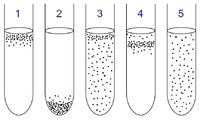
Photo from wikipedia
Repairing oxidative‐targeted macromolecules is a central mechanism necessary for living organisms to adapt to oxidative stress. Reactive oxygen and chlorine species preferentially oxidize sulfur‐containing amino acids in proteins. Among these… Click to show full abstract
Repairing oxidative‐targeted macromolecules is a central mechanism necessary for living organisms to adapt to oxidative stress. Reactive oxygen and chlorine species preferentially oxidize sulfur‐containing amino acids in proteins. Among these amino acids, methionine can be converted into methionine sulfoxide. This post‐translational oxidation can be reversed by methionine sulfoxide reductases, Msr enzymes. In Gram‐negative bacteria, the antioxidant MsrPQ system is involved in the repair of periplasmic oxidized proteins. Surprisingly, in this study, we observed in Escherichia coli that msrPQ was highly expressed in the absence of oxygen. We have demonstrated that the anaerobic induction of msrPQ was due to chlorate (ClO3−) contamination of the Casamino Acids. Molecular investigation led us to determine that the reduction of chlorate to the toxic oxidizing agent chlorite (ClO2−) by the three nitrate reductases (NarA, NarZ, and Nap) led to methionine oxidation of periplasmic proteins. In response to this stress, the E. coli HprSR two‐component system was activated, leading to the over‐production of MsrPQ. This study, therefore, supports the idea that methionine oxidation in proteins is part of chlorate toxicity, and that MsrPQ can be considered as an anti‐chlorate/chlorite defense system in bacteria. Finally, this study challenges the traditional view of the absence of Met‐oxidation during anaerobiosis.
Journal Title: Molecular Microbiology
Year Published: 2022
Link to full text (if available)
Share on Social Media: Sign Up to like & get
recommendations!